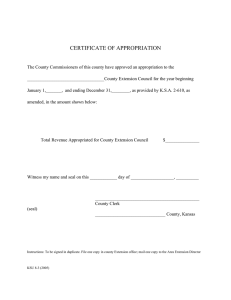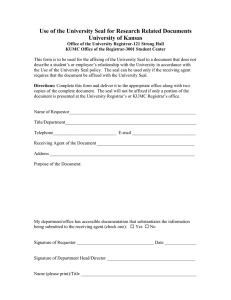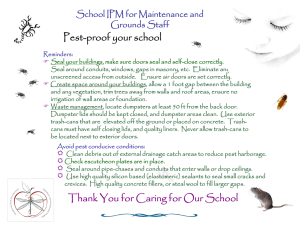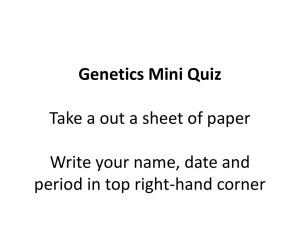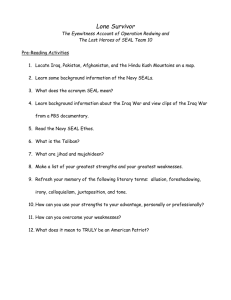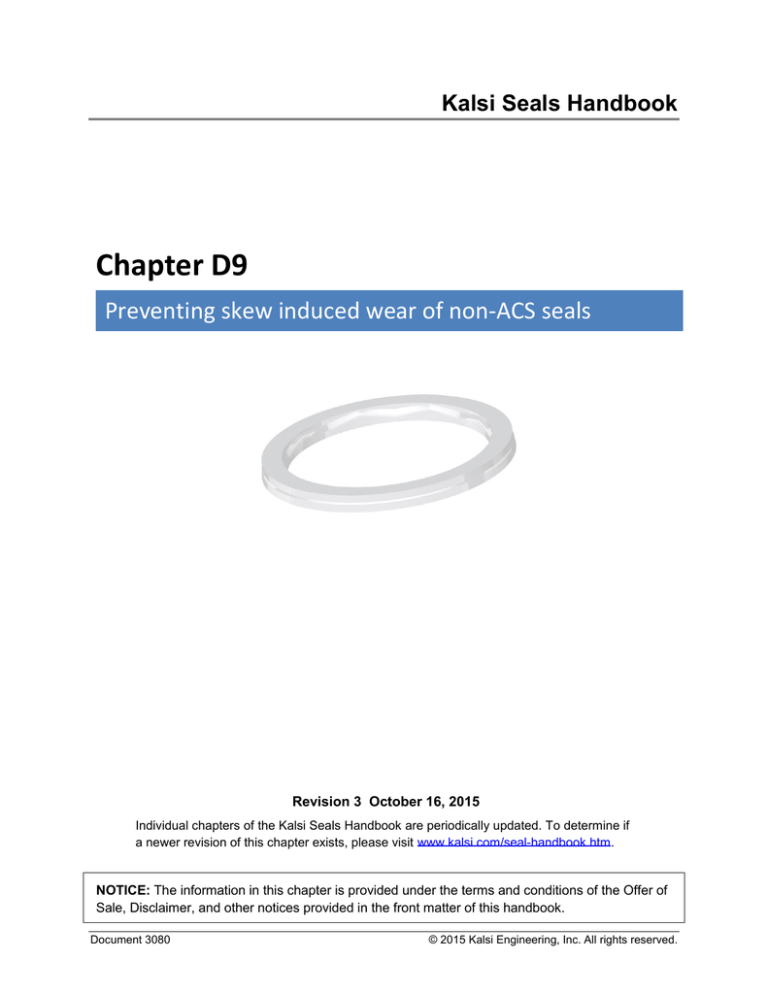
Kalsi Seals Handbook
Chapter D9
Preventing skew induced wear of non-ACS seals
Revision 3 October 16, 2015
Individual chapters of the Kalsi Seals Handbook are periodically updated. To determine if
a newer revision of this chapter exists, please visit www.kalsi.com/seal-handbook.htm.
NOTICE: The information in this chapter is provided under the terms and conditions of the Offer of
Sale, Disclaimer, and other notices provided in the front matter of this handbook.
Document 3080
© 2015 Kalsi Engineering, Inc. All rights reserved.
Preventing skew induced wear of non-ACS seals
1.
Chapter D9 Page 1
Introduction
In abrasive service applications with little or no differential pressure, or low level
reversing pressures, all Kalsi Seals except ACS1 seals require axial spring loading to
inhibit skew induced wear. Initial radial compression, and thermal expansion during
service, cause circumferential compression of the seal. In the absence of differential
pressure or spring loading, this circumferential compression promotes local buckling,
which skews a portion of the seal relative to the direction of rotation (Figure 1). Because
of the skew, environmental abrasives are swept into the dynamic sealing interface, and
the seal experiences premature abrasive wear (Figure 2).
Springs should be used in compensation pistons that do not use ACS seals
A mud motor pressure compensation piston is an example of an application where
low levels of reversing pressure occur. The lubricant pressure is nominally the same as
the drilling fluid pressure, but can be either higher or lower due to piston friction. The
ACS seal was developed for such applications, but is not available in all sizes and
temperature ranges. Because skew induced wear can be a very aggressive wear
mechanism, axial spring loading is highly recommended for all non-ACS seals that are
used in pressure compensation pistons for abrasive service applications.
2.
A description of skew induced wear
Seal skewing is due to the combined effects of compression and thermal expansion
(see Figure 1). The initial radial compression of the seal also imparts a degree of
circumferential compression. Thermal expansion of the seal during operation imparts
additional circumferential compression. In a manner similar to the buckling of long
slender columns, the seal can become locally skewed as a result of the circumferential
compression, in the absence of differential pressure. As little as 15 psi (103 kPa) of
lubricant pressure will prevent such skewing at 162°F (72.2°C), but establishing such
differential pressure is not practical in all applications.
If skewing is present, rotation can cause environmental abrasives to impinge upon
and abrade the dynamic sealing lip, and consequently abrade the shaft. If not destroyed
by other wear mechanisms, the seal wear pattern caused by skew is distinctive because it
is non-parallel to the flat ends of the seal (Figure 2). The tell-tale skewed wear pattern is
usually destroyed by other wear mechanisms, because the skew induced wear relaxes
some of the circumferential compression.
1
ACS is an acronym for "Axially Constrained Seal" (see Chapter C4).
Contact Kalsi Engineering
Search this handbook
Preventing skew induced wear of non-ACS seals
Chapter D9 Page 2
Seal skewing does not necessarily occur every time a non-axially constrained Kalsi
Seal is used in a balanced pressure condition, but it will occur often enough to
significantly reduce reliability and correspondingly raise equipment maintenance costs.
Skew induced wear is a very aggressive wear mechanism when it does occur. In order to
assure consistent performance with any type of rotary shaft seal that is exposed to
abrasives, skew induced wear must be addressed.2
Figure 1
Skew induced wear mechanism
Non-axially constrained seals can skew in low differential pressure conditions due to
compression and thermal expansion. Rotation causes abrasive fluid to impinge at the
skewed location, which can drive abrasives under the seal and cause accelerated wear.
2
For example, in our experience, conventional lip-type axle bearing seals on commercial vehicles can easily have a
five to one variation in life depending on how squarely they are seated against their respective shoulders.
Contact Kalsi Engineering
Search this handbook
Preventing skew induced wear of non-ACS seals
Chapter D9 Page 3
..
Figure 2
Skew induced wear example
This 3.145” ID (79.88 mm) seal was used downhole in an oilfield mud motor barrier
compensation piston for 50 rotating hours, and was no longer effective due to the abrasive
effect of the drilling mud. Close examination revealed that the wear pattern varies in width,
which is proof of skew induced wear. The next run of the tool used an axially spring loaded
seal, and had much better used seal condition after 100 hours of rotation.
3.
Using differential pressure to prevent skew induced wear
Our laboratory tests with 2.75” (69.85 mm) seals and low pressure extrusion gap
clearance indicates that differential pressure acting from the lubricant side of the seal can
be used to prevent skew induced wear. A lubricant over-pressure of 15 psi (103 kPa) is
enough to prevent skew induced wear at 162°F (72.2°C), and an over-pressure of at least
22 psi (152 kPa) is enough to prevent skew induced wear at 375°F (190.6°C). The
differential pressure, acting from the lubricant side of the seal, prevents skew induced
wear by holding the seal flat against the environment side groove wall.
Our tests were typically performed with abrasive drilling fluid vented to atmospheric
pressure. In some applications, the process fluid is pressurized, and the pressure
fluctuates rapidly. For example, in oil well surface equipment applications such as
rotating control devices, the drilling fluid pressure fluctuates rapidly as a result of mud
pump design.
In such cases, the lubricant over-pressure has to be great enough to maintain a
positive pressure differential even when the drilling fluid pressure fluctuations reach
maximum values. Since adjustments to the lubricant pressure may lag behind increases in
drilling fluid pressure, the lubricant over-pressure value needs to be set high enough to
Contact Kalsi Engineering
Search this handbook
Preventing skew induced wear of non-ACS seals
Chapter D9 Page 4
prevent lag related pressure reversals. (Pressure reversals also cause shuttling related seal
wear.) Published literature3 on rotary control device (RCD) sealing indicates that a 200 to
300 psi (1.38 to 2.07 MPa) lubricant over-pressure is adequate with computer controlled
pressurization systems which use a pinch valve to control the pressure of a circulating
lubricant.
When using spring loaded piston amplifier type lubricant reservoirs in oil well
surface equipment, a lubricant over-pressure in the range of about 160 to 240 psi (1.10 to
1.65 MPa) is enough to deal with mud pump related pressure spikes and piston related
lubricant pressure lag. This is just the over-pressure value that was arbitrarily selected; no
attempt was made to tease out minimum acceptable over-pressure values.
4.
Using axial spring loading to prevent skew induced wear
In Kalsi Seal applications with little or no differential pressure, or low levels of
reversing pressure, axial spring loading should be used to prevent skew induced wear if
an ACS is not available in the correct size and temperature range. Differential pressure
conditions can be difficult to predict in some types of equipment. If you are unsure
whether or not axial spring loading is needed, leave room in your design, just in case you
find that it is required.
Barrier seals are also desirable in reversing pressure situations
In addition to spring loading, the use of an outboard barrier seal (Chapter D10) is
also desirable in seal implementations that are subject to reversing pressure. By providing
a clean lubricated environment, a barrier seal can help to prevent Kalsi Seal abrasion
damage resulting from pressure induced seal distortion and axial shuttling motion within
the groove.
In applications where the reversing pressure is due to slow pressure compensation
piston response, the situation can be improved by substituting a fast responding
diaphragm.
Various types of springs can be used
A typical spring loaded rotary seal implementation is shown in Figure 3. While the
figure illustrates the use of wave springs to preload the seal, the use of other types of
springs is possible. For example, expired US patents 1,089,789 and 3,015,505 teach and
illustrate the use of a circle of coil type compression springs in pockets to axially preload
rotary shaft seals. Figures 4 and 5 show how wave and coil springs can be implemented
3
See US Patents 6,554,016, 6,749,172, 7,004,444, 7,007,913, 7,836,946, and 7,934,545.
Contact Kalsi Engineering
Search this handbook
Preventing skew induced wear of non-ACS seals
Chapter D9 Page 5
in pressure compensation pistons. As shown in Figures 3 to 5, a removable groove wall
permits installation of the seal, a backup washer, and the springs. The backup washer
distributes the spring force uniformly around the circumference of the seal. The springs
and backup washer are located on the clean lubricant side of the seal, so that they cannot
become jammed from contaminants within the environment.
Limiting seal shuttling in reversing pressure conditions
In some applications, such as compensation pistons4, the differential pressure acting
from the abrasive environment side may occasionally exceed the lubricant pressure. In
such transient reversing pressure situations, the seal may shuttle axially in the groove,
and as a result may temporarily become skewed with respect to the direction of shaft
rotation. Although undesirable, axial shuttling causes less harm with a spring loaded seal
because any skewing that occurs involves cocking on the flat plane defined by the backup
washer, instead of local seal buckling.
Runout
The spring force recommendations provided in this chapter were tested with 0.010”
(0.25 mm) runout on a 2.75” (69.85 mm) shaft at 400 rpm using 0.335” (8.51 mm) cross
section seals and a 17-4 PH condition 1025 seal carrier. Scuffing of the environment side
groove wall occurred due to runout related radial sliding motion of the inner portion of
the seal relative to the groove wall. This scuffing was noted even with relatively low
spring loads.
A surface finish of 32 in (0.20 m) AA or less is recommended for the inner two
thirds of the environment side groove wall to prevent anchoring of seal material, which
can accelerate seal abrasion. The outer third of the groove wall can be rougher to inhibit
circumferential slippage of the seal within the groove.
The cumulative effect of environment side groove wall abrasion can be minimized
by defining the environment side groove wall with a replaceable ring. The replaceable
groove wall should be a relatively tight fit with the groove bore to help prevent clearance
variations at the extrusion gap, which may accelerate rotary seal abrasion. Replaceable
environment side groove walls should be keyed or pinned to prevent rotation.
4
In oil well downhole drilling equipment, reverse pressure transients can occur from things like compensation
system hysteresis, swab pressure resulting from dropping the tool deeper in the hole, pressure drop that occurs
along the length of the tool, or wellbore hole collapse. For a description of swab and surge pressure, see U.S.
Patent 6,220,087. For information on wellbore hole collapse, see Bourgoyne, et. al., Applied Drilling
Engineering,1991 and Bradley, et. al, Petroleum Engineering Handbook, 1992 (Society of Petroleum
Engineers, Richardson, TX).
Contact Kalsi Engineering
Search this handbook
Preventing skew induced wear of non-ACS seals
Chapter D9 Page 6
Another way to minimize environment side groove wall abrasion is to employ a
shaft guided seal carrier that follows the dynamic motion of the shaft. This approach
provides a number of benefits, including:
Minimizing the impact of rotary seal compression set by minimizing compression
variations,
Minimizing shaft and rotary seal wear that occurs when abrasives trapped in the
extrusion gap are crushed and displaced by shaft lateral motion, and
Minimizing nibbling type damage related to spring-induced seal extrusion (Such
damage is more prevalent with FEPM dynamic sealing lips).
Figure 3
A wave spring and backup washer can be used to constrain Kalsi Seals perpendicular
to the axis of shaft rotation to enhance abrasive exclusion in applications having little
or no differential pressure. In this figure, the removable groove wall has extensions to
limit shuttling of the seal during transient reverse pressure conditions. The extensions
can be built into either the backup washer or the removable groove wall. Although the
removable groove wall is illustrated on the lubricant side in this figure, as an
alternative, the environment side groove wall could be removable provided that it is
well guided to maintain concentricity. Conventional retaining rings are a convenient
way to secure removable groove walls.
Ideally, a spring loaded seal implementation will limit the magnitude of the shuttling
motion to only the amount of clearance that is needed to accommodate the maximum
Contact Kalsi Engineering
Search this handbook
Preventing skew induced wear of non-ACS seals
Chapter D9 Page 7
anticipated thermally expanded width of the seal. This anticipated width should include
some margin for error in temperature estimate. In Figure 5, the shuttling motion is limited
by the amount of clearance between the backup ring and the removable groove wall that
is defined by the journal bearing portion of the seal carrier. In Figures 3 and 4, the
shuttling motion is limited by over travel extensions. If the anticipated transient reverse
pressures are quite low, only one such extension is needed, preferably at the OD. If
transient reverse pressures can potentially be high, the use of two extensions would be
preferred (as shown in Figure 3) to prevent excessive pressure induced deformation of the
backup washer and seal cross sections.
The over travel extensions can be designed to project from the backup washer or
from the removable groove wall, and should be designed so that the springs cannot hang
up on them. In Figure 3, this has been accomplished by tapering the inner extension, and
by causing the outer extension to telescope over a portion of the backup washer.
Figure 4
A mud motor compensation piston with a wave spring loaded Kalsi Seal
In this oilfield mud motor pressure compensation piston, the Kalsi Seal is axially preloaded
with a wave spring to prevent skew induced wear. Three radial retaining pins in matchreamed holes hold the assembly together. The pins are retained by the housing bore. In
Kalsi Engineering’s seal research mud motor, this type of compensation piston design
allowed the Kalsi Seal to perform much better as a mud seal.
Contact Kalsi Engineering
Search this handbook
Preventing skew induced wear of non-ACS seals
Chapter D9 Page 8
Figure 5
A mud motor compensation piston with a coil spring loaded Kalsi Seal
In this oilfield mud motor pressure compensation piston, the Kalsi Seal is axially preloaded with a
circle of coil springs to prevent skew induced wear. Three radial retaining pins in match-reamed
holes are used to hold the assembly together. The backup washer is keyed to the piston with an
anti-rotation tang to prevent rotation that could bind the projecting ends of the springs. If desired,
the anti-rotation tang could be axially oriented instead of radially oriented. The surface of the
backup washer that contacts the Kalsi Seal can be grit blasted to inhibit circumferential slippage
of the Kalsi Seal. Designs that incorporate fewer than 3 coil springs should be avoided because
they promote tipping-induced rotary seal skew in reverse pressure conditions.
How much spring force?
The amount of applied spring force varies with the width of the seal, which varies
due to tolerances and thermal expansion. Estimated seal widths in various temperature
and tolerance conditions are provided in Appendix 2. If the Kalsi Seal you intend to use
is not represented in Appendix 2, contact Kalsi Engineering for assistance.
Contact Kalsi Engineering
Search this handbook
Preventing skew induced wear of non-ACS seals
Chapter D9 Page 9
To make our spring force recommendations applicable to a wide variety of seal
sizes, we provide the recommendations in pounds per square inch (psi) of equivalent
pressure, rather than in pounds. To calculate equivalent pressure, Ep in pounds per square
inch, divide the spring force Sf in pounds by the circular area of the seal gland, use the
following equation:
Equation 1, Equivalent pressure:
Ep = Sf / ((G/2)2xPI - (S/2) 2xPI)
See Figure 3 for the variables G and S. Our general purpose spring force
recommendation for 80 to 90 durometer Shore A5, non-dual durometer6 seals is:
At least 15 psi 103 kPa) equivalent pressure at the 162°F (72.2°C) seal width.
At least 22 psi (152 kPa) equivalent pressure at the 375°F (190.6°C) seal
width.
No more than 45 psi (310 kPa) equivalent pressure at the MMC seal width at
the maximum anticipated seal temperature7. (80 and 90 durometer seals with
Enhanced Lubrication waves have been successfully tested at 300°F
(148.9°C) with 45 psi (310 kPa) equivalent pressure8, but they have not been
tested at higher temperatures with spring loading.)
For maximum conservatism, apply recommendations in the first two bullet items at
LMC seal dimensions and a lower bound estimate of thermal expansion, and apply the
recommendation in the third bullet item at the upper bound estimate of thermal
expansion9. This degree of conservatism is not always possible with high temperature
capable seals, because it severely narrows the spring choice and may preclude the use of
off the shelf coil springs. One can certainly rationalize the use of nominal seal
dimensions instead of LMC dimensions in regard to the first two bullet items, because the
mold design and the molding process makes LMC seal dimensions unlikely.
5
6
7
8
9
While spring loading is believed to be practical with softer seal materials in some wave patterns, test data is not
available. Spring force will probably have to be reduced in proportion to the reduced modulus of the softer seal
material.
At the time of this writing, few dual durometer seals have been tested in spring loaded conditions.
Composite High Temperature Kalsi Seals have been successfully tested at 390°F (198.9°C) against drilling fluid
with a combination of 45 psi (310 kPa) equivalent spring load and 45 psi lubricant pressure, assuming a 13E-5
in/in/°F coefficient of thermal expansion.
The 300°F (148.9°C) spring force calculations were based on MMC seal dimensions and a 13E-5 in/in/°F
coefficient of thermal expansion.
We use 13E-5 in/in/°F as an estimate for the upper bound of linear thermal expansion for HNBR, FEPM, and
FEPM/FKM composite seals.
Contact Kalsi Engineering
Search this handbook
Preventing skew induced wear of non-ACS seals
Chapter D9 Page 10
Understanding causes of seal width variation
The spring(s) must be designed to accommodate seal width variations while
maintaining a useful level of skew resisting force. Seal width variations are related to a
number of variables, including seal diameter10, temperature, tolerances, mounting
clearances, and shaft deflection. Temperature is often the most significant variable,
because the coefficient of thermal expansion of elastomers is much higher than metals.
Typical published coefficients of linear thermal expansion for various elastomers
are shown in Table 1. Volumetric thermal expansion is three times greater than linear
thermal expansion. We typically use a coefficient range of thermal expansion of 13E-5
in/in/°F when calculating HNBR seal width for spring loading purposes.
Table 1
Typically quoted values for
linear thermal expansion
Elastomer
Linear expansion,
in/in/°F x 10-5
NBR & HNBR
6.2 to 13
EPDM
8.9
FKM
8.3 to 15.0
The rotary seal is hotter than the environment during rotation because of interfacial
lubricant shear. If the environment circulates through the shaft to draw heat away, the
seal can be conservatively estimated to be about 50°F (27.8°C) hotter than the
environment. For more complex installations with less efficient heat transfer, thermal
finite element analysis can be used to predict seal temperature by using estimated rotary
seal torque to determine the seal generated heat input for the analysis.
Avoid over confinement of the seal by the spring washer
The most serious spring implementation mistake is seal over confinement caused by
failure to anticipate the maximum thermally expanded seal width. This over confinement
can cause increased interfacial contact pressure, and can cause the seal body to flatten
against the shaft (Figure 6), impeding hydrodynamic lubrication, causing increased
10 Seal diameter influences circumferential compression, which affects installed axial width of the seal.
Circumferential compression is greater with smaller diameter seals, so the installed width of smaller diameter seals
is greater than the installed width of larger diameter seals having the same cross sectional dimensions; see
Appendix 2.
Contact Kalsi Engineering
Search this handbook
Preventing skew induced wear of non-ACS seals
Chapter D9 Page 11
frictional torque and heat, and potentially causing premature seal failure. When severe
over confinement occurs, the typical tell-tale signature is wear across the entire width of
the seal (i.e. wear on surfaces that should not be contacting the shaft11) and/or extrusion
damage. The extrusion damage may appear at one or both ends of the seal12.
Correct
Wave springs
Wave springs
No room for seal
thermal expansion
GA1196.10
Planned room for seal
thermal expansion
Incorrect
Because of planned
thermal expansion room,
Kalsi Seal retains shape
as temperature increases
Rotary shaft
Backup washer
Due to lack of thermal
expansion room, entire
ID of seal flattens against
shaft, losing lubrication
Figure 6
If the spring and backup washer arrangement is not designed to accommodate the
thermal expansion and tolerances of the rotary seal, the thermal expansion will cause
the seal to flatten against the shaft and lose lubrication.
Excessive spring force can over flatten and damage the seal
A related mistake is to apply too much spring force. The combined effects of high
axial spring force and seal thermal expansion cause the seal body to expand toward the
shaft. Excessive spring force, especially in combination with elevated temperature, can
cause the seal body and the hydrodynamic edge of the dynamic sealing lip to flatten
completely against the shaft. This also can impede hydrodynamic lubrication, and cause
premature seal failure13.
11 Such a wear signature may also indicate high reverse pressure acting across the rotary seal.
12 Extrusion damage on the lubricant end of the seal may also indicate high reverse pressure acting across the seal.
13 In a rotary test of -8 FEPM seals with springs calculated to provide about 81.5 psi (562 kPa) equivalent pressure at
350°F (176.7°C), the seal bodies were completely flattened against the shaft at a bulk lubricant temperature of
Contact Kalsi Engineering
Search this handbook
Preventing skew induced wear of non-ACS seals
Chapter D9 Page 12
Because axial spring load causes radial expansion of the seal body, it also increases
effective installed radial interference. If desired, credit for this radial expansion can be
taken when designing the groove diameter G.
For best results, minimize reversing pressures
Spring loading improves abrasive wear resistance of the seal in applications with low
transient reverse pressure conditions. This is true even if the spring induced equivalent
pressure is less than the reverse pressure transient, although the rotary seal does shuttle
axially. Such pressure responsive shuttling is undesirable because environmental media
can pack between the seal and the environment side groove wall and tilt the seal, and
because the seal may traverse worn or contaminated portions of the shaft. For best
performance, minimize the reverse pressure potential by providing efficient pressure
balancing of the lubricant to the environment.
5.
Backup washer design
The backup washer should be guided by a non-binding slip fit with the groove bore
Gmin, and typically it should have enough clearance with the shaft to prevent contact
under any combination of tolerance, backup washer misalignment, and shaft deflection.
Worst case backup washer to shaft clearance can be determined by subtracting the
following from the minimum concentric radial clearance:
The maximum concentric groove diameter Gmax to washer radial clearance,
The maximum radial manufacturing eccentricity of the backup washer,
The maximum shaft to seal carrier lateral offset due to mounting clearances, and
The maximum lateral shaft deflection from the highest anticipated side load.
When designing the axial thickness of the backup washer, the spring force, the
number of coil springs or wave spring waves, and the magnitude of reverse pressure must
be considered so that the backup washer does not deflect significantly between spring
contact points (Figure 7). Flimsy backup washers are unsuitable because they deflect
significantly under reverse pressure, which imparts a wavy shape to the exclusion edge of
the seal and promotes seal abrasion. The backup washer should be a continuous ring to
maximize rigidity. We used a 0.1” (2.54 mm) thick backup washer for our tests. This
backup washer thickness had a predicted deflection of 0.0027” (0.07 mm) with 61 psi
375°F (190.6°C), but were not completely flattened against the shaft at a bulk lubricant temperature of 160°F
(71.1°C).
Contact Kalsi Engineering
Search this handbook
Preventing skew induced wear of non-ACS seals
Chapter D9 Page 13
(421 kPa) reverse pressure using the load case shown in Figure 7, and 0.0026” (0.04 mm)
using FEA. Less deflection is better than more deflection, in terms of abrasive exclusion.
Figure 7
To prevent skew induced seal wear, the thickness of the backup washer must be
sized so that very little deflection occurs when the seal is exposed to reverse pressure
acting from the environment side. A quick and dirty way to calculate is to use the
closed form solution for a continuous beam that has two equal spans and uniform
loading. One source for such a formula is Machinery’s Handbook.
If one or more over travel projections are used, they should be sized to allow travel
up to the desired maximum groove width.
Designing the backup washer to inhibit seal slippage
Spring loading helps to inhibit circumferential seal slippage by increasing the
frictional force between the seal and the environment side groove wall. If desired, the
backup washer can be keyed to the housing (Figures 8, 9 and 10) and the backup washer
surface facing the seal can be roughened to further inhibit circumferential seal slippage.
One appropriate surface roughening method is the grit blasting process described in
chapter D5, provided that the cylindrical surfaces of the backup washer are masked.
Figure 8
To inhibit circumferential seal slippage, the face of the backup washer can be roughened, and the
outer periphery of the backup washer can form an anti-rotation tang that engages a longitudinal
slot in the seal carrier.
Contact Kalsi Engineering
Search this handbook
Preventing skew induced wear of non-ACS seals
Chapter D9 Page 14
Figure 9
In this cutaway view of a pressure compensation piston, the spring loaded backup washer
incorporates an axially oriented anti-rotation tang. The surface of the backup washer that contacts
the Kalsi Seal can be grit blasted (See Chapter D5) to inhibit circumferential slippage of the seal.
Figure 10
An over-travel extension is sometimes used with backup washers that are used with wave
springs. As this figure illustrates, the anti-rotation tang can project from the over-travel extension.
Contact Kalsi Engineering
Search this handbook
Preventing skew induced wear of non-ACS seals
6.
Chapter D9 Page 15
Wave spring design
Kalsi Engineering does not manufacture or sell springs of any type, but provides free
coil spring design software on our website. Distributors of off-the-shelf springs usually
provide extensive spring performance data and material selection guidance in their
literature. Custom spring manufacturers typically have staff experts who can provide
comprehensive spring design services, often at no cost. Be sure to select a spring material
that is compatible with anticipated operating temperature.
If you are designing your own wave springs, software is recommended because of
the number of design iterations that are typically required for optimization. Such software
is offered by some wave spring manufacturers as a courtesy. Spring material properties
are available from a variety of sources, including the Spring Manufacturer’s Institute,
Wheeling, Illinois. Spring design formulas and guidelines are also available from a
variety of sources.
Wave spring load predictions are considered to be relatively accurate up to 75 to
80% of full deflection if the mean diameter to radial width aspect ratio is greater than 8.
Wave springs produce greater force during compression, and less force during unloading,
due to friction from movement against mating surfaces (including other wave springs).
Design the spring outer diameter (OD) to be bore guided by a non-binding slip fit
with groove diameter Gmin. Wave spring diameter increases with spring compression, and
the spring will cease to function if it is constrained from expanding by the groove. If the
spring is constrained from expanding by the groove, it will not allow the seal to thermally
expand freely, and may result in rapid seal destruction. This is a critical consideration,
especially with non-gap type wave springs.
When designing the spring fit within the groove diameter Gmin, if the spring
approaches full compression in your design (which is not recommended), the maximum
spring OD can simply be assumed to be the MMC14 OD of the spring blank prior to
forming the waves. If the spring does not approach full compression in your design, the
maximum effective spring diameter should be calculated based on maximum spring
compression. The minimum spring OD can be calculated based upon predicted minimum
spring compression, or can be simply assumed to be the LMC OD of the spring in the
relaxed state. The spring blank diameter increases as a function of the number and height
of waves. By increasing the number of waves, the load capacity goes up for a given
material thickness, but the deflection range goes down.
14 MMC stands for “Maximum Material Condition”, and LMC stands for “Least Material Condition”; for more
information see ASME Y14.5M – 1994: Dimensioning and Tolerancing.
Contact Kalsi Engineering
Search this handbook
Preventing skew induced wear of non-ACS seals
Chapter D9 Page 16
If an over travel projection is used on the backup washer, the spring should have a
non-binding slip fit with it. If an over travel projection is not used, the spring ID should
have enough clearance with the shaft to prevent contact under any combination of
tolerance, spring lateral offset, and shaft deflection. When designing the fit with the shaft,
the minimum spring ID can be calculated based upon predicted minimum spring
compression, or can simply be assumed to be the MMC ID of the spring in the relaxed
state. Worst case shaft to spring clearance can be determined by subtracting the following
from the minimum concentric radial ID clearance between the spring and the shaft:
The maximum concentric groove bore to spring OD radial clearance,
The maximum spring OD to ID radial manufacturing eccentricity,
The maximum shaft to seal carrier lateral offset due to mounting clearances, and
The maximum lateral shaft deflection from the highest anticipated side load.
At deflections above 75 to 80%, the actual spring load progressively increases above
the load predicted by calculation. The preferred way to implement wave springs is to
compress them by less than 75 to 80% at the maximum predicted rotary seal width, and
use an over travel limiter to prevent excess seal shuttling15 (see Figures 3 and 4). Because
of the deflection limiter, a spring can be used which has relatively little force change over
the required stroke. For example, the spring in one of our tests had a calculated spring
force of about 27.7 psi (191 kPa) equivalent pressure at the room temperature seal width,
and 32.0 psi (221 kPa) at the predicted 350°F (176.7°C) seal width.
A surface finish of 32 in (0.80 m) AA or less is recommended for the mating load
bearing surfaces of the spring and backup washer to minimize sliding friction. A spring
load tolerance of 20 to 25% is generally achievable, but should not be specified at
deflections greater than 75% or less than 25%. The spring should be lubricated during
load testing to minimize friction.
Spring designs that incorporate fewer than 3 waves should be avoided because they
promote tipping-induced rotary seal skew in reverse pressure conditions. Spring wave
height should be as uniform as possible in order to minimize reverse pressure tilting. For
the sake of uniformity, continuous circle type wave springs must be formed using
dedicated dies, rather than by hand (i.e. bending over bars).
15 Another possible way to implement wave springs is to design them to be compressed by approximately 75 to 80%
at the maximum predicted rotary seal width. The remaining deflection serves as a buffer to prevent overconfinement if temperatures go higher than anticipated.
Contact Kalsi Engineering
Search this handbook
Preventing skew induced wear of non-ACS seals
Chapter D9 Page 17
For small diameter seals, a relatively short spring wave pitch and thin spring stock
must be used, and it may be necessary to use several springs in parallel to achieve the
required load and deflection capability.
Kalsi Engineering wave spring experience has been limited to 17-7 PH condition CH
900 precipitation hardening stainless steel. This material was selected on the basis of its
elevated temperature capacity and strength. It is typically available in (but not limited to)
thicknesses of 0.005”, 0.008”, 0.010”, 0.012”, 0.025”, 0.031”, 0.035” and 0.042” (0.13,
0.20, 0.25, 0.30, 0.64, 0.79, 0.89 and 1.07 mm) and has a minimum ultimate tensile
strength of 240,000 psi (1,655 MPa) and a minimum 0.2% yield strength of 230,000 psi
(1,586 MPa). As a general rule, the allowable stress for static and low cycle wave spring
loading can be regarded as 100% of tensile strength at 75% deflection (80% of tensile
strength for austenitic steels and non-ferrous alloys) provided that pre-setting is used
during manufacture to create favorable residual stresses16. Consult your spring
manufacturer for material and stress recommendations for specific service conditions and
manufacturing procedures.
Stagger gaps if you must use gap type wave springs
Avoid gap type wave springs if possible because they are much more flexible at the
location of the gap. Under transient reverse pressure conditions, the rotary seal will tilt
toward the gap, causing skew induced seal wear. If gap type wave springs cannot be
avoided, two springs should be used in parallel with the gaps oriented 180 apart (Figure
11) to minimize seal tipping in reverse pressure conditions.
16 Adapted from published literature, and a discussion with a local wave spring manufacturer regarding 300°F
(148.9°C) service.
Contact Kalsi Engineering
Search this handbook
Preventing skew induced wear of non-ACS seals
Chapter D9 Page 18
Figure 11
If gap type wave springs must be used to axially load a Kalsi Seal, two springs should
be used in parallel with the gaps oriented 180° apart (as shown here). This helps to
minimize seal tipping in conditions where the environment pressure is temporarily
higher than the lubricant pressure.
Contact Kalsi Engineering
Search this handbook

